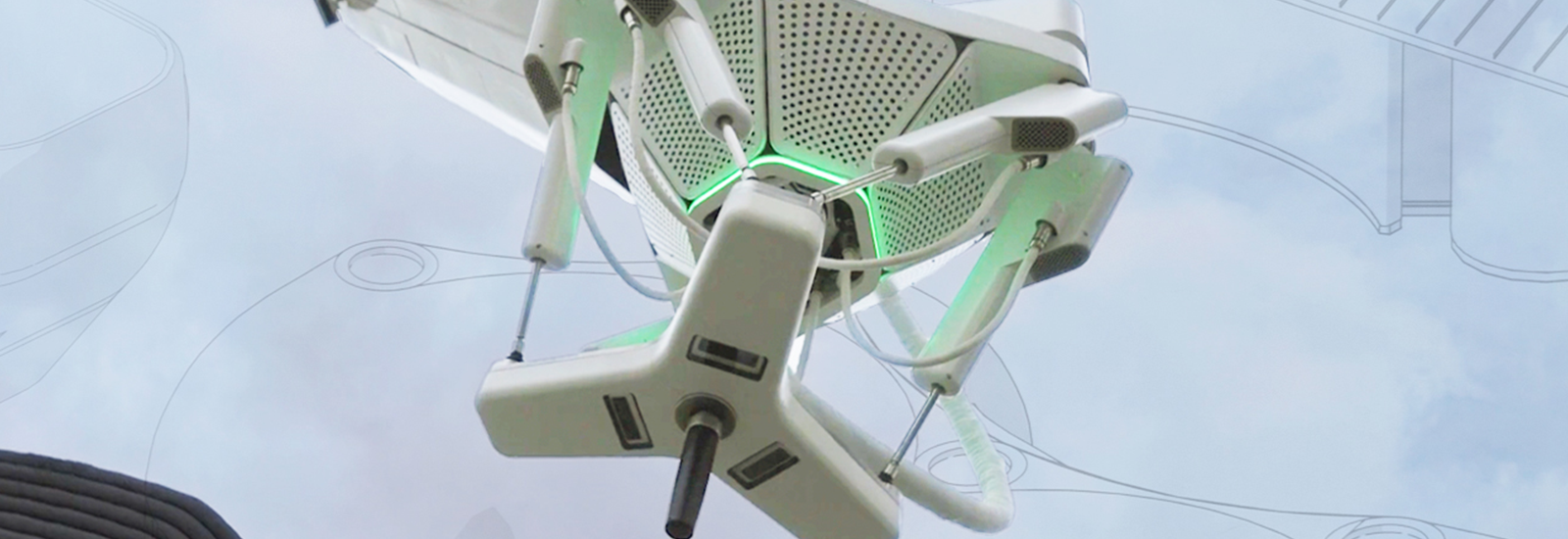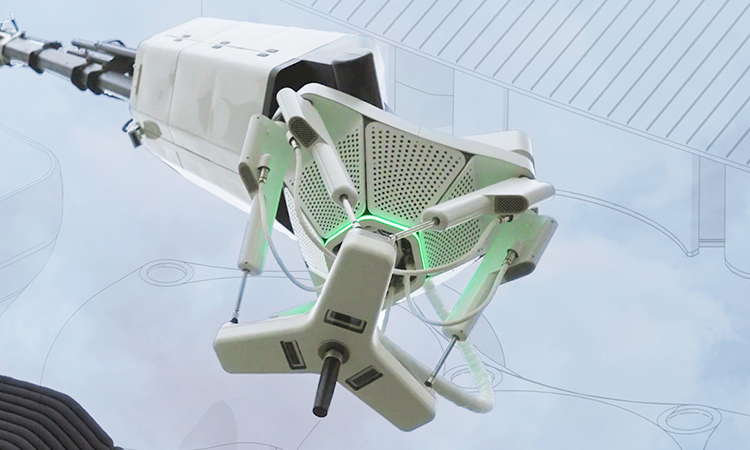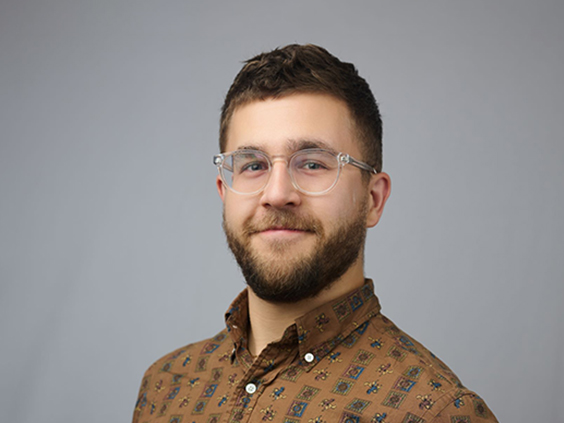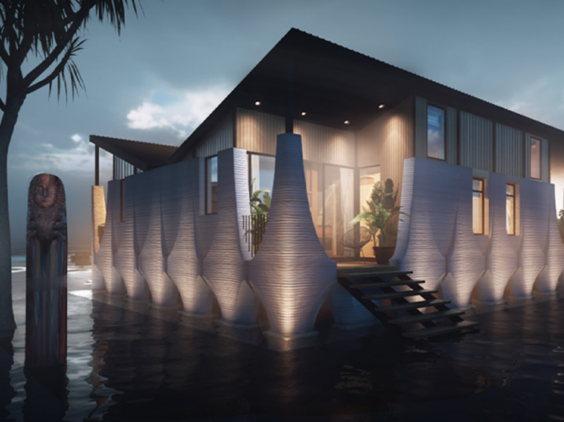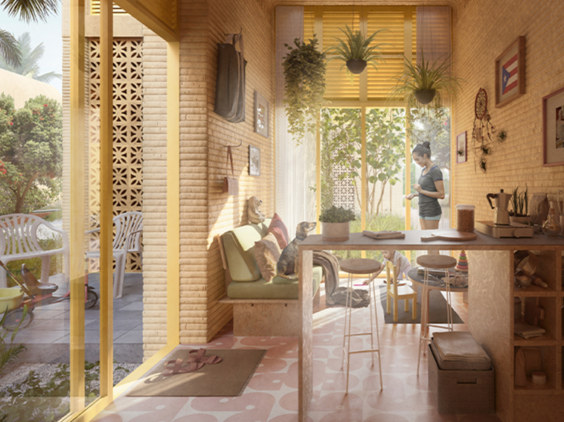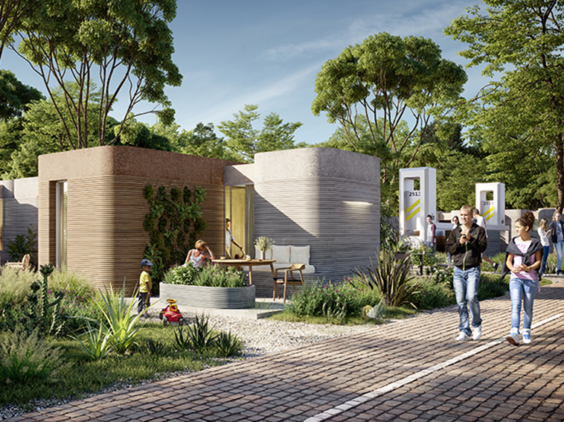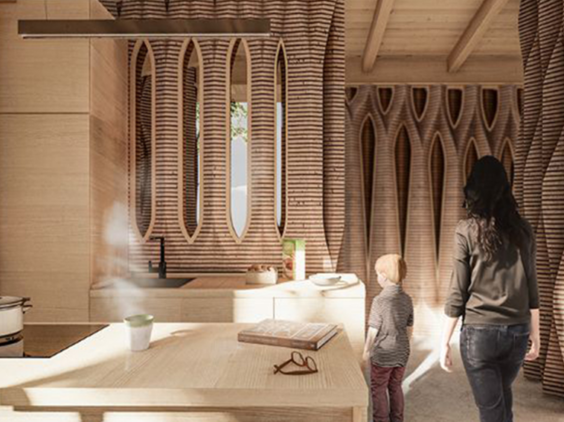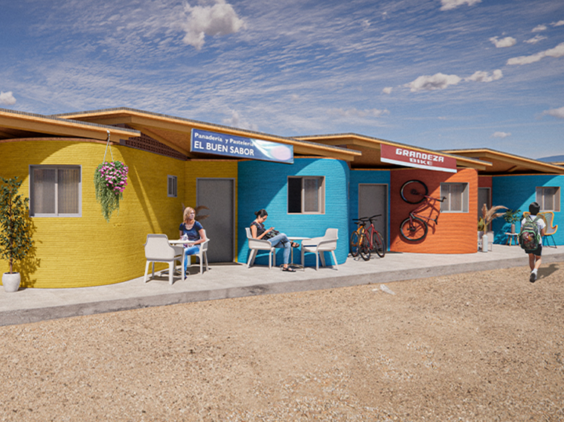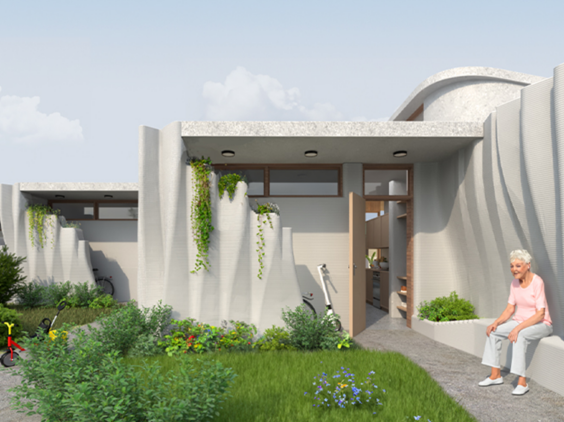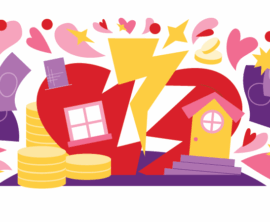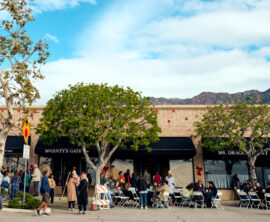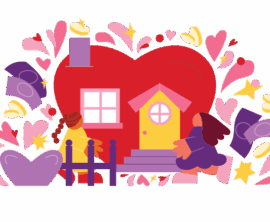Key takeaways
- ICON, a Texas-based startup, aims to use robotic printing to address the global housing crisis.
- ICON launched Initiative 99, an international competition challenging architects to design homes that could be affordably constructed by its 3D printers for $99,000 or less.
- With a Wells Fargo grant, the nonprofit Mobile Loaves & Fishes will see the first buildouts among these Initiative 99 designs in its supportive neighborhood for underhoused individuals and families.
- The six winning designs are also available to homebuilders and architects nationally via ICON’s open-source catalog of ready-to-print architecture.
Around the world, communities are asking the same question: How do we make housing more accessible to everyone? One solution is to build differently, from the ground up.
Inside the Community First! Village outside of Austin, Texas, one such homebuilding tool has taken shape: one of the country’s first occupied 3D-printed homes. But they’re far from the last.
With some help from Wells Fargo, rapidly developing robotic 3D-printing technology is being combined with cutting-edge design and community-building to help address the housing gap. The result will be 3D-printed homes that are more resilient and imaginative in the face of climbing homebuilding costs and global crises like climate change.
“Housing alone will never solve homelessness, but community will. I think what you see in Community First! Village is the manifestation of community. We need community, that human to human, heart to heart,” said Alan Graham, founder and CEO of Mobile Loaves & Fishes, whose supportive neighborhood outside of Austin houses more than 370 people coming out of chronic homelessness.
[Video overview: This video features Alan Graham, Founder & CEO of Mobile Loaves & Fishes; Darlene Goins, President of Wells Fargo Foundation; Jason Ballard, Co-Founder & CEO of ICON; Melodie Yashar, Vice President, Building Performance & Design at ICON; and Mona Peters, Co-Founder & Design Director at MTspace Studio talking about the impact of ICON’s work in developing affordable 3D-printed homes with support from Wells Fargo.]
[Music]
[Alan Graham, Founder & CEO, Mobile Loaves & Fishes]
They’re pretty much the lost and forgotten. These are the people that are the most special to us.
[Off-screen voices]
Alright. We’ve got a big crowd going.
Great.
Hi everyone. Welcome. Welcome. Welcome.
[Graham]
And everything about what we’re doing here is 100% about building community.
[On-screen text]
Mobile Loaves & Fishes
[Graham]
So come on in.
[Darlene Goins, President, Wells Fargo Foundation]
Wells Fargo decided to invest in Initiative 99 because the idea of having the best architects and the best student architects around the world brings the kind of innovation that we really need to be able to accelerate the production of affordable housing in this country.
We’re working with ICON with their 3D printed technology to be able to print quality, affordable, and safe homes.
[On-screen text]
SXSW
[Jason Ballard, Co-Founder & CEO, ICON]
We’ve partnered with Wells Fargo to undertake a global design challenge. To find a way to design homes with dignity to be built for $99,000 or less. So today the Initiative 99 Phase 1 winners were announced. We’ve picked two locations that we’re actually going to build winning designs.
[Melodie Yashar, Vice President, Building Performance & Design, ICON]
Wells Fargo has shown a true commitment to making real progress in affordable housing. I’d like to welcome to the stage president of the Wells Fargo Foundation, Darlene Goins.
[Goins]
Wells Fargo is contributing $500,000 in grant funding to Mobile Loaves & Fishes to help build the first I-99 designed homes to serve the underhoused.
[Graham]
We’re sitting in the middle of Community First Village, and it is currently a 51-acre master plan community headed to a 176-acre master plan community designed around microhomes designed to lift the most chronically homeless men and women of the streets of Austin up off the streets. Of our 535 homes so far, ICON has printed 17.
[Mona Peters, Co-Founder & Design Director, MTspace Studio]
We got super excited about 3D-printed architecture, because we really see globally the whole building industry so stagnating in the last decades. That 3D printing is really a godsend alternative where we finally have a solution for the global housing crisis.
[Graham]
The phrase that we use often is that housing alone will never solve homelessness, but community will. And I think what you see here in the Community First Village is really the manifestation of community.
[On-screen text]
© 2024 Wells Fargo Bank, N.A. All rights reserved.
Watch the video: In Austin, ICON, Wells Fargo, and Mobile Loaves & Fishes come together to advance innovative affordable housing.
Credit: Hector Batista
In 2020, the nonprofit partnered with Austin-based ICON, a construction technology company, to build 3D-printed homes for some of its residents. Now that partnership is growing with Initiative 99. The international design competition tasks architects to create a new kind of affordable home that’s only possible through 3D printing for a construction price tag of $99,000 or less, and are also resilient, dignified, and environmentally friendly. The first phase culminated at SXSW in Austin, where ICON announced six winning designs from around the world. With a $500,000 grant from the Wells Fargo Foundation, one or more of those designs will be built at scale within an upcoming Community First! Village expansion.
Plus, all the winning designs are available for homebuilders and architects across the nation to use to create high-quality affordable housing in their own communities via ICON’s digital home catalog, CODEX. Darlene Goins, president of the Wells Fargo Foundation and head of Philanthropy and Community Impact at Wells Fargo, said the competition is a “gamechanger for the housing industry,” which will push the envelope for designing lower-cost, quality housing for the people and families who need it most.
“These international design competitions don’t usually happen for affordable housing,” said ICON co-founder and CEO Jason Ballard. “The hope is that dozens and dozens, if not hundreds or thousands, of homes come into the world because of Initiative 99.”
6 innovative features of the I99 home designs
Here’s how the winning designers use 3D printing as inspiration to create entirely new styles of affordable homes. Watch their stories here. (1:32:18)
What are the benefits of a 3D-printed home?
ICON develops large-scale robotics, software, and advanced materials to build homes faster and more affordably. Their Vulcan construction systems, for example, weighing in at roughly one-ton, automate construction (1:11) of their characteristically layered walls, while roofs, windows, and doors are built using traditional methods.
3D-printed homes can be built faster and for less money
A recently unveiled multi-story robotic construction system called Phoenix introduces the capability of printing an entire building enclosure including foundations and roof structures. By increasing speed and size and decreasing setup time and the number of required operators, this advanced robotic system will reduce ICON printing costs by half.
Ultimately, there could be a “quantum leap” in reducing housing costs, Ballard said.
“We finally have a solution for the global housing crisis to speed things up and produce the housing that we need,” said I99 winner Mona Peters.
3D-printed homes create new design possibilities
ICON’s printers specialize in building curved and bespoke designs quickly and more economically compared to traditional methods because 3D printers streamline a home’s design and build materials.
For example, I99 winner Victoria Roznowski added adaptable sleeping areas and a wavy exterior in her winning design, which she envisioned serving refugees in her native Germany.
“I truly believe 3D printing can revolutionize the way we’re building houses right now,” she said.
3D printing promotes resilient and sustainable homebuilding
These homes don’t just promote sustainability through efficient automation, but in their building materials, too. For example, ICON’s robotic printers dispense the company’s own formulation of low-carbon concrete (2:30).
The startup says its homes produce far less waste than the four tons left over after building the average home in the U.S. Many of the I99 designs go further to promote water conservation, efficiently scaled communities, and other sustainable features.
How to 3D print your own home
Interested in your own 3D-printed home? Try an open-sourced design.
ICON’s CODEX is a home design catalog of ready-to-print architecture plans for developers, architects, and homebuyers. Among the dozens of available designs in the catalog are the six I99 phase 1 winners. Other categories focus on storm- and fire-resilient homes, Texan architecture, and more.
If you like a design, you or your architect can reach out to ICON or take a virtual tour (1:17). The company has 3D-printed homes on the market.
